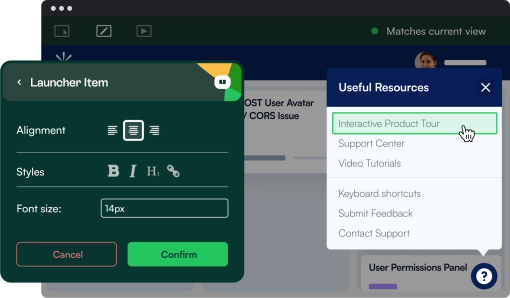Think of product benchmarking as a game of poker.
Poker players have to keenly study their opponents and make educated guesses based on past moves, risk tolerance, and subtle tells.
In the same way, SaaS companies use product benchmarking to analyze their competitors and stay on top of their performance based on specific metrics.
This article will help you perform benchmarking analysis from start to finish and lead your product to victory, no matter who the competitor is.
Product benchmarking analyzes your product and business strategies against competing products to find out how you stack up.
Strategic benchmarking can guide your product development efforts, helping you optimize product performance and outrank your competition.
A product benchmarking process starts with goal-setting and choosing the products/companies you want to use as a reference point.
Selecting the main benchmarks is important because these metrics will determine the next steps to increase performance.
What is product benchmarking? #
Product benchmarking analyzes your product’s performance and functionality against competitors’ to identify areas of improvement and enable strategic development of your product roadmap. It also helps you define key differentiators and establish your competitive positioning.
A product benchmarking process typically covers:
Feature comparisons to pinpoint any missing features and find your high-value features
Pricing to estimate the right price points for your product and avoid over/undercharging
Key performance indicators to compare how you’re faring against the competition
Quality and customer satisfaction to gauge your product’s effectiveness
Financial benchmarking to assess your position in terms of revenue
Brand recognition to see where you stand in the market
Put simply, product benchmarking finds performance gaps and opportunities to ensure you’re keeping pace with your competitors and identifying areas where you can deliver more.
Why is product benchmarking important? #
Competitive benchmarking tells product-led growth companies where they’re ahead and behind the competition. It tells you what the best-in-class products are doing and how you can outperform them.
That’s not all. Here are four benefits you can gain from investing in consistent benchmarking:
Build your competitive advantage: Benchmarking pinpoints your competitors’ strengths and weaknesses. You can use this information to guide your development efforts and build a more robust solution.
Stay on top of customer expectations: Product benchmarks that consider user feedback and needs eliminate guesswork from building new product capabilities. You know what customers expect and build exactly what they need.
Embrace first principles thinking: Analyzing your competition can help you discover what they're not doing. This is your space to drive innovation and solve problems more creatively.
Improve the user experience: Performance benchmarking data compares your product’s speed, bugs, reliability, and other parameters against others. This helps in finding possible improvements in your user experience to drive product adoption.
Besides these benefits, strategic benchmarking also helps you proactively identify threats from new entrants in the market. This is critical to adjusting your product roadmap and boosting your competitive edge.
How to conduct product benchmarking: an actionable playbook #
Preparing for your first product benchmarking analysis can feel overwhelming, especially if you operate in a crowded market with many competitors.
You're likely juggling multiple questions—which competitors to choose? How to collect relevant data? Which product performance benchmarks to track?—and the list keeps getting longer.
Luckily for you, we’ve got the As to your Qs—and we’re about to break product benchmarking down into four actionable steps.
Let’s go.
1. Set your goals and objectives #
The first step is setting the goals for your benchmarking process. You have to consider multiple parameters when setting these goals, such as:
Industry: Companies prioritize different goals based on the sector and vertical they're operating in. A health tech SaaS company will focus more on product benchmarks related to regulatory compliance and data security. In contrast, a sales-related software company will aim to increase efficiency and ease of use.
Business model: Your business model can significantly influence your benchmarking goals. For example, if you have a high-touch sales model, your goals should revolve around acquisition and lifetime value. On the other hand, if you have a freemium model, you’ll likely want to focus on user experience, free-to-paid conversion, and time-to-value.
Product type: The product type factors in the complexity of your product and the problems it solves. If you’re selling a complex product for payroll management, you’ll prioritize goals for faster onboarding and customer success, while simpler tools solving less urgent problems—like a note-taking tool—will aim to maximize daily active users.
Customers: Your target customers and consumer preference also impact your benchmarking goals. If you have project management software for enterprise teams, you have to put more emphasis on key metrics related to retention. However, if you’re mostly selling to individuals—like invoicing tools for freelancers, you have to look at churn rate and user growth.
In addition to these factors, the type of benchmarking—internal or external—can also influence your goals.
Internal benchmarking involves analyzing different teams' performances to determine the most effective ways to achieve a goal. In contrast, external benchmarking compares your product’s performance to other similar products and identifies opportunities for improvement.
2. Select your top competitors and benchmark metrics #
Once you’re ready with your goals, the next step is deciding who you’re competing against. Choosing your competitors is a crucial decision because it directly impacts your understanding of the market and ultimately shapes your growth strategy.
Use these best practices to shortlist the right competitors for your competitive analysis:
Consider direct competitors operating in a similar stage as you
Compare products with similar capabilities or feature overlaps
Consider indirect competitors with the same business model as yours
Add leading brands with high industry recognition to add valuable external benchmarks
Here’s a template to consolidate and compare all competitors based on these categories:
Competitor Name | Operating Stage | Product Capabilities | Business Model | Industry Recognition |
Company A | Similar | High overlap | Same | High |
Company B | Similar | Moderate overlap | Same | Moderate |
Company C | Similar | Low overlap | Same | Low |
Company D | Different | High overlap | Same | High |
Company E | Different | Moderate overlap | Same | High |
Use a combination of tools like Crunchbase, G2, Capterra, and other forums to facilitate your research. Talk to your existing customers (or those who fit the bill in terms of company size, location, and personas) to find out their top tools for your product’s use cases.
3. Collect and analyze data #
Effectively capturing product data is the first step to proper benchmarking. With so many metrics to choose from, you can’t randomly pick the key metrics for your benchmarking process. Besides, you might not find your competitors’ product data publicly for every metric. You'll have to likely rely on various third-party tools or services such as 6sense.
Instead of working sporadically with whatever data you find, here are a few broad types of metrics to track for all competitors:
Adoption: Track product adoption for your competing brands by measuring their sign-ups and downloads. You can also find user base growth rate in their publicly available resources.
Stickiness: Analyze other products’ ability to engage users in the long term and bring them back to the product continuously. Find data around daily active users (DAUs) to get insights into customer loyalty.
Engagement: Check user engagement on competing products by calculating metrics like number of sessions per user, features used, time spent on the platform, etc. This data can be sourced from user reviews, surveys, and third-party research.
Satisfaction: Assess how happy or frustrated users are with other products by running a CSAT survey or getting the data directly from the competitors.
You can also track other metrics to measure user retention and churn. While not every metric will be available publicly, product performance benchmarks exist in the form of industry research and benchmarking reports. You can also collect data through secondary sources like news and media coverage, marketing collateral, and relevant reports to identify world-class performance.
Remember to align your product benchmarks with your goals to make this more useful.
4. Implement insights from your analysis #
The final step is executing your decisions into a product development process based on the benchmarking report. Prioritize the insights based on impact and outline your goals for the next round of benchmarking. Then create a roadmap to help every team achieve specific targets and improve your product and company’s performance.
Take a timeline-based approach with regular check-ins to track employee performance and ensure everyone’s on track to achieve the targets.
Make this a continuous process until you re-evaluate your past performance and create a new benchmarking report.
3 Best practices for product benchmarking #
Before you embark on your product benchmarking journey, here are three best practices to make your product benchmarks airtight and measure performance seamlessly.
1. Set realistic goals and benchmarks #
Without the right goals for your benchmarking process, you’re simply throwing spaghetti on the wall and hoping something sticks. The result? Wasted resources, stagnated growth, and frustration.
Instead of setting goals randomly, or going for wildly ambitious goals, consider your company’s relative performance and market position to think realistically about the benchmarking process.
Don’t push your limit to become the best product overnight. Focus on identifying opportunities to achieve superior performance and fuel user adoption through steady progress. Assess your resources and business processes to define achievable goals. Remember, aim for iteration, not perfection.
2. Choose relevant metrics #
Your benchmarking report is only as good as the metrics you choose to consider. If you go for the wrong ones, your analysis will lead you in the wrong direction and waste time on unimportant goals.
The rule of thumb here is to align your metrics with your goals. To consider customer satisfaction, look at metrics like net promoter score, user retention, and churn rates. This will help you discover competitors performing better than you in customer satisfaction and gather data to improve your past performance.
3. Continuously monitor and adjust #
Product benchmarking isn’t a one-and-done process. You’ll see decent ROI only when you regularly monitor and review your performance.
Remember to adjust your benchmarks as you move forward and your product roadmap changes. Monitoring the market and finding new competitors in your vertical are equally important to build a continuous improvement model.
Consistent benchmarking can unlock actionable and valuable insights to enhance your user experience and boost your bottom line.
Turn benchmarks into business success #
Benchmarking your product gives you a relative analysis of your product's own past performance against your key competitors. It uses competing companies as reference points to indicate performance gaps that can make your product better than the rest, and that's something your entire company benefits from.
With this quick guide, you’re now ready to benchmark your solution against competitors and develop more focused product development efforts.
Remember to invest enough time in identifying and researching your top competitors. Explore different tools and channels to gather enough data about these products and make your benchmarking process airtight—prepare for it like an unbeatable player of product benchmarking poker!

Easily Optimize and Iterate Your Product
Apply your product benchmarking insights into your UX in minutes.




